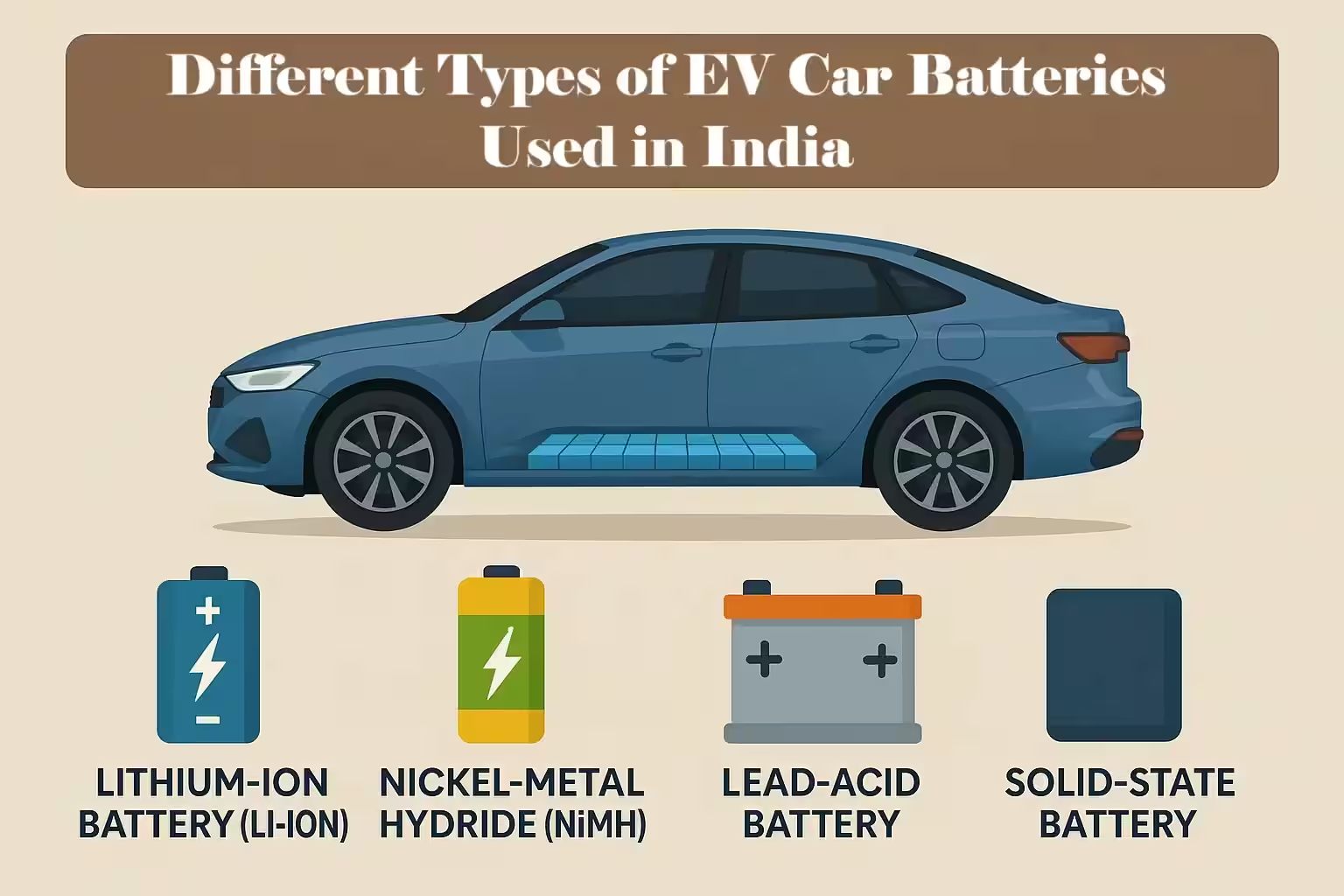Hedhvick Hirav
Hedhvick Hirav is a dedicated EV researcher and editor with over 4 years of experience in India’s growing electric vehicle ecosystem. Their contributions have been recognized in leading sustainability publications and automotive journals.
Summarize & analyze this article with
Choose an AI assistant and open this article directly:
Tip: if the AI doesn’t fetch the page automatically, paste the article URL manually.

What is the difference in EV battery performance in Indian weather and driving conditions?
Indian conditions are special: hot summers, heavy monsoons, and dense traffic. What is the performance of various batteries?
- LFP: Best suited to heat and humidity. Not sensitive to temperature changes.
- NMC: An excellent material, except when thermal runaway conditions arise and make it troublesome.
- Lead-Acid: Gets aged fast in hot conditions; performance drops in summers.
- NiMH/Sodium-ion: Preliminary results indicate good thermal stability, but little mass-market application.
Mean Indian Customer Battery Hours (2025):
- LFP: More than 8 years or 2500+ cycles
- NMC: 1,500-2,000 cycles; 6-8 years
- Lead-Acid: 1-2 years 400-600 cycles
The Indian road conditions (bumps, potholes) do not affect battery chemistry, but high heat does.
Expert Insight:
In India, EV battery warranties have generally been raised to a better 8 years/160,000 km (LFP and NMC) implying that manufacturers are bullish on their lasting performance even in rigorous Indian circumstances.
What are the Battery Types of Which Indian EV Brands in 2025?
Below you will find a top 10 list of Indian EV manufacturers and battery choices to make your decision easier:
| Brand/Model | Type of Battery | Max. Range (km) | Price Band (Rs.) | Special Feature | Charging Time (90-100%) |
|---|---|---|---|---|---|
| Tata Nexon EV | LFP | 325-465 | 15-19 lakh | 8-yr warranty, made-in-India cells | 56 min (fast charge) |
| MG ZS EV | NMC | 419-461 | 18-25 lakh | i-Smart BMS, global battery supply | 50 min |
| Mahindra XUV400 | LFP | 375-456 | 15-18 lakh | 7-yr warranty, strong BMS | 50 min |
| Ola S1 Pro | LFP | 195 | 1.3-1.5 lakh | Battery swap pilot, domestic cells | 18 min (hypercharge) |
| Ather S450x | NMC | 150 | 1.4-1.6 lakh | OTA, AI-powered BMS updates | 15 min (fast charge) |
| TVS iQube | LFP | 145 | 1.2-1.4 lakh | Made in India, high safety | 21 min (fast charge) |
| Bounce Infinity E1 | LFP | 85-100 | 99,000-1.1 lakh | Swappable battery, city use | 2 hr (fast charge) |
| Hero Electric Photon | Lead-Acid/Li-ion | 80-108 | 85,000-1 lakh | Mainstream, no-frills battery swapping | 3-4 hrs (normal) |
| Bajaj Chetak | NMC | 108 | 1.3-1.5 lakh | Luxury finishing, extended warranty | 60 min (fast charge) |
| Okinawa Praise Pro | Lead-Acid/Li-ion | 88-120 | 80,000-1 lakh | Cheap, best seller | 3-4 hrs (average) |
- Tata and Mahindra: Domestic supply LFP and adequate cost/safety.
- MG & Ather: NMC to be used in higher range, focus on urban commuters/enthusiasts.
- Hero Electric and Okinawa: Provides lead-acid and Li-ion (LFP) to price-conscious consumers.
- Ola / TVS: LFP, and Ola is testing sodium-ion in 2025.
- Bounce: Betting on battery swapping to meet fast urban transportation demands.
Did You Know?
By 2025, more than 75 percent of all new electric two-wheelers in India will be powered by LFP batteries due to their durability and compatibility with the Indian climate.
What will the Cost of Replacing an EV Battery in India be in 2025?
Indian consumers are very sensitive to the price of battery replenishment which is another major element of EV running costs.
Revisiting Battery (2025):
- LFP (Car, ~30-40 kWh): 2.5-4 lakh
- NMC (Car, ~40-50 kWh): 3.5-5 lakh
- LFP/NMC (Scooter, ~3 kWh): 30,000-55,000
- Lead-Acid (E-Rickshaw): 15,000-25,000
- NiMH/Sodium-ion: No commercial data available in India yet
- Solid-State: Not available 2025
What Influences the Cost of Batteries?
- Cell chemistry (LFP is less expensive than NMC)
- Customs tariffs (Indian-made-cells are now cheaper)
- Battery pack size/capacity
- GST prices (5% on batteries, as of 2025 policy)
- Government subsidy (on FAME II eligible vehicles)
Most new EVs have warranty coverage that usually implies that you will not have to pay to replace it within at least 8 years.
Expert Insight:
Ola Electric lowered the cost of battery replacement by 20 percent between 2023 and 2025 through local suppliers and new chemistry mixes.
How does the EV Battery Recycling work in India?
Recycling is a hot topic in India as EVs age. This is what you should know:
Government Regulation:
India has Battery Waste Management rules which require all EV manufacturers to collect and recycle used batteries by 2025.
Recycling Process:
- Firms such as Attero and Tata Chemicals recycle up to 90 percent of metals in batteries.
- Stationary storage (solar, backup power) or recycling of old batteries is used.
User Responsibility:
When your EV battery expires, you hand it over to the authorised service centre/manufacturer to recycle.
No battery is to be discarded in ordinary waste—penalties may be incurred.
Did You Know?
In 2024, India recycled more than 12,000 metric tonnes of used EV batteries, and capacity is projected to triple by 2027.
What is the Best EV Battery Type in India?
In case you are interested in the best range and performance, this is what you should know:
- NMC batteries have the best energy density, thus they are selected in high-end cars such as the MG ZS EV—providing up to 461 km on a single charge.
- LFP batteries are not far behind, now providing 325-465 km in vehicles such as Tata Nexon EV, and stronger safety in hot climates.
- Lead-acid and NiMH are not competitive—usually less than 100 km per charge.
- Sodium-ion is promising, but only demos in 2025.
User Story:
Priya in Mumbai replaced a lead-acid e-scooter with an LFP-based Ola S1.
My old scooter would hardly cover 55 km with a full charge. I can reliably get 130+ km with LFP, even during rains!
Indian government policy and subsidies towards the electric vehicle battery industry.
Indian government investment is dependent upon Battery willingness:
- FAME II Subsidies: Advanced batteries: Up to 10,000 rupees per kWh
- PLI Scheme: Allows national production of LFP and NMC batteries
- Battery Swapping Policy: Battery swapping is a recognised business model of two-wheelers and rickshaws
- Advanced chemistry batteries (LFP/NMC) have incentives.
Most subsidies are not available to lead-acid batteries in 2025.
Expert Insight:
In India, government schemes have reduced the average cost of EV batteries by 18 percent in three years to 2025, making EVs more affordable to the middle class.
What are the Best Ways to Maintain and Maximise the Life of Your EV Battery in India?
To make sure your investment stands the test of time, the following are tips on how to take care of your batteries in India:
Best Practices:
- Do not drain completely: Charge 20-80 percent per day.
- Charge in shade: Particularly in hot Indian summers.
- Charge with manufacturer chargers: Do not use local/unauthorised charging points.
- Service: Visit the authorised service centres and check the battery condition once in a year.
- Never disregard warnings: Modern BMS provides you with warnings—heed them!
The majority of contemporary Indian EVs are equipped with safety measures to manage heat and charging mistakes.
Things to Avoid:
- Charging in direct sunlight at noon
- Leaving the EV idle and with an empty battery over months
- Filling with wrong chargers or charged sources
Did You Know?
EVs that have regular software/BMS updates (such as Ather, Tata) maintain 92 percent battery health after 5 years of city driving, according to 2025 service records.
What Do Real Indian Users Say About Various Types of EV Batteries?
Case Study 1:
Tata Nexon EV User, Delhi
Purchased in 2022. Even after 3 years and 32,000 km, battery health stands at 95%. The range is no less, and I drive daily in the 40C heat. LFP battery is very reassuring.
Case Study 2:
Lucknow, E-Rickshaw Owner
2 years of used lead-acid. Needed to change battery after 14 months. Last year switched to Li-ion model—initial cost more but no headache, and running cost cut in half.
Case Study 3:
Ather 450X Owner, Bengaluru
NMC battery charges super fast. Findings: What is the Best EV Battery in India 2025? Office commute is good, but I keep it inside to prevent heat.
Findings: What is the Best EV Battery in India 2025?
- LFP (Lithium Iron Phosphate) is the most suitable option in 2025 among most Indian users.
- It is a compromise between cost, safety, and performance, which is perfect in Indian temperatures and city commutes.
- NMC is excellent when you need the maximum range and do not mind the additional price (suitable to MG or Ather enthusiasts).
- Lead-acid is only an option when you are on a very tight budget or when you are buying entry-level e-rickshaws.
- Sodium-ion and Solid-State are promising but not yet mass-market-ready in India.
In 2025, an LFP-based EV will be the best choice to have peace of mind and low running costs.
Cut-down 2025 (Indian Context) FAQs
Q1. What is the longest-lasting battery in Indian EVs?
A: LFP (Lithium Iron Phosphate) batteries are longer living; typically 8+ years, with 2,500+ charge cycles even in hot India.
Q2. In 2025, will I be able to buy an EV that has a lead-acid battery?
A: Lead-acid batteries are cheap, require frequent replacements, and are less safe and efficient. Preferably LFP or NMC.
Q3. Are all types of EV batteries subsidized by the Indian government?
A: No. FAME II subsidy and GST advantageous apply to advanced batteries like LFP and NMC, but not on lead-acid.
Q4. How much does it cost to replace an EV battery in India in 2025?
A: Replacement costs: cars 2.5-5 lakh; scooters 30,000-55,000—depending on battery size and chemistry.
Q5. Can you ever get an upgrade to a better battery type on your EV?
A: Not normally, because battery packs are model-specific. Most companies do not offer to change the chemistry (e.g., lead-acid to LFP).
Disclaimer:
The article is founded on the most recent data as of 2025. Technology, prices, and government policies can shift quickly in battery technology. Remember to verify the information with your EV manufacturer and read the recent government notifications before coming to a decision.
Share it with other EV lovers or check out the new and latest LFP and NMC battery EVs at a dealer near you!


